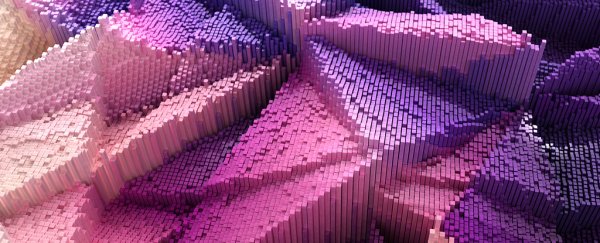Experiments carried out on a complex arrangement of magnetic particles have identified a completely new state of matter, and it can only be explained if scientists turn to quantum physics.
The messy structures behind the research show strange properties that could allow us to study the chaos of exotic particles - if researchers can find order in there, it could help us understand these particles in greater detail, opening up a whole new landscape for quantum technology.
Physicists from the US carried out their research on the geometrical arrangements of particles in a weird material known as spin ice.
Like common old water ice, the particles making up spin ice sort themselves into geometric patterns as the temperature drops.
There are a number of compounds that can be used to build this kind of material, but they all share the same kind of quantum property – their individual magnetic 'spin' sets up a bias in how the particles point to one another, creating complex structures.
So, unlike the predictable crystalline patterns in water ice, the nanoscale magnetic particles making up spin ice can look disordered and chaotic under certain conditions, flipping back and forth wildly.
The researchers focussed on one particular structure called a Shakti geometry, and measured how its magnetic arrangements fluctuated with changes in temperature.
States of matter are usually broken down into categories such as solid, liquid, and gas. We're taught on a fundamental level that a material's volume and fluidity can change with shifts in its temperature and pressure.
But there's another way to think of a state of matter - by considering the points at which there's a dramatic change in the way particles arrange themselves as they gain or lose energy.
For example, the freezing of water is one such dramatic change - a sudden restructuring that occurs as pure water is chilled below 0 degrees Celsius (32 degrees Fahrenheit), where its molecules lose the energy they need to remain free and adopt another stable configuration.
When researchers slowly lowered the temperature on spin ice arranged in a Shakti geometry, they got it to produce a similar behaviour - one that has never been seen before in other forms of spin ice.
Using a process called photoemission electron microscopy, the team was then able to image the changes in pattern based on how their electrons emitted light.
They were noticing points at which a specific arrangement persisted even as the temperature continued to drop.
"The system gets stuck in a way that it cannot rearrange itself, even though a large-scale rearrangement would allow it to fall to a lower energy state," says senior researcher Peter Schiffer, currently at Yale University.
Such a 'sticking point' is a hallmark of a state of matter, and one that wasn't expected in the flip-flopping madness of spin ice.
Most states of matter can be described fairly efficiently using classical models of thermodynamics, with jiggling particles overcoming binding forces as they swap heat energy.
In this case there was no clear model describing what was balancing the changes in energy with the material's stable arrangement.
So the team applied a quantum touch, looking at how entanglement between particles aligned to give rise to a particular topology, or pattern within a changing space.
"Our research shows for the first time that classical systems such as artificial spin ice can be designed to demonstrate topological ordered phases, which previously have been found only in quantum conditions," says physicist Cristiano Nisoli from Los Alamos National Laboratory.
Ten years ago, quasiparticles that behaved like magnetic monopoles were observed in another type of spin ice, also pointing at a weird kind of phase transition.
Quasiparticles are becoming big things in our search for new kinds of matter that behaves in odd but useful ways, as they have pontential to be used in quantum computing. So having better models for understanding this quantum landscape will no doubt come in handy.
This research was published in Nature.
